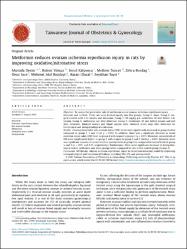Metformin reduces ovarian ischemia reperfusion injury in rats by improving oxidative/nitrosative stress

View/
Access
info:eu-repo/semantics/openAccessDate
2021Author
Demir, MustafaYılmaz, Bülent
Kalyoncu, Şenol
Tuncer, Meltem
Bozdağ, Zehra
İnce, Onur
Bozdayı, Mehmet Akif
Ulusal, Hasan
Taysi, Seyithan
Metadata
Show full item recordCitation
Demir, M., Yilmaz, B., Kalyoncu, S., Tuncer, M., Bozdag, Z., Ince, O., Bozdayi, M. A., Ulusal, H., & Taysi, S. (2021). Metformin reduces ovarian ischemia reperfusion injury in rats by improving oxidative/nitrosative stress. Taiwanese journal of obstetrics & gynecology, 60(1), 45–50. https://doi.org/10.1016/j.tjog.2020.10.004Abstract
Objective: To assess the preventive role of metformin on rat ovarian ischemia reperfusion injury. Materials and methods: Forty rats were divided equally into five groups; Group 1: sham, Group 2: surgical control with 3-hr torsion and detorsion, Group 3: 50 mg/kg p.o. metformin 30 min before 3-hr torsion, Group 4; metformin just after detorsion, Group 5; metformin 30 min before torsion and just after detorsion. Bilateral ovaries and blood sample were obtained seven days after detorsion for biochemical and histopathological evaluation. Results: Ovarian tissue total anti-oxidant status (TAS) levels were significantly increased in group 4 when compared to group 1, 2 and 3 (all p < 0.01). In addition, there was a significant decrease in tissue oxidative stress index (OSI) level in group 4 with respect to group 2 (p < 0.01). Moreover, serum levels of OSI were significantly higher in group 2 with respect to group 1 and 5 (both p < 0.05). Similarly, there was significant increase in serum levels of peroxynitrite in group 2 as compared to serum levels in group 3 and 5 (p < 0.01 and 0.05, respectively). Furthermore, there were significant decrease in histopathological scores metformin and sham groups when compared to rats in the control group (Group 2). Conclusion: Metformin reduces ischemia reperfusion injury in rat torsion detorsion model by improving histopathological and biochemical findings including TAS, OSI and peroxynitrite. © 2020

















